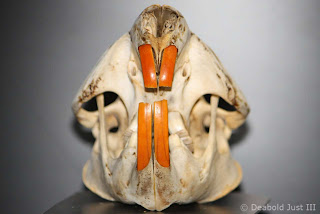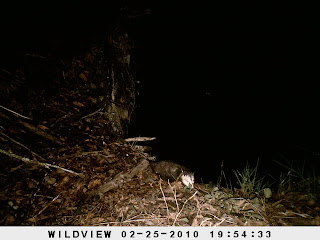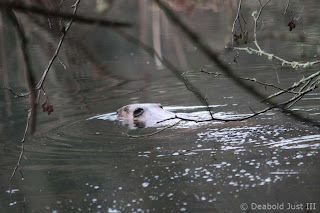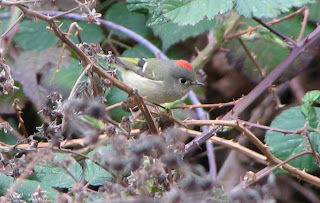In writing my last Blog , Dam it Damn it, I collected more material then I could get in there due to my excitement about getting the beaver’s picture posted for all to see. There was a lot more to what I saw on my quest to capture the pictures then the end result.
I grew up in Wisconsin and went to public school. I remember science of the day made such a big deal as to how superior mankind was over the other animals. MAN ...the maker of tools. MAN...the "namer" of things, MAN has an opposable thumb, blaa blaa blaa. I struck me in a funny way, just as much as science wanted to displace religion and dogma to answer the questions of life it was becoming a religion in it’s self with MAN as the pinnacle of what evolution was about, and we were there. So what was the difference? Man was the answer either way.
I started some shit in my high school anthropology class while the instructor was going on about the superiority levels of the different hominids over the millions of years. He and I got along very well but he was an ass and was quick to point it out when he introduced himself. He took pleasure in seeing how wound up he could get students to express what they thought and would argue the opposite view to make them refine their thoughts so they improve their skills at how they expressed themselves. ( This did however put him at odds with parents, fellow faculty members, school management and the school board ). “Tools” he claimed were the single crystallizing and defining thing that separated man from all other animals. We had walked on the Moon, end of subject.
My argument was that man was not the only tool maker and user. The examples I used came from the nature shows of the era. They showcased Egyptian Vultures using rocks to break eggs, Galapagos Finches selecting and using thorns to probe out insects from dead wood and Chimpanzees using plant fibers to tease termites out of their underground colonies. He argued each one on it’s own merits and discounted them in order. He lost it and had trouble finding his way back when I argued the role of the beaver as an urban planner and construction company. He could deal with the others to a point but a rodent was not going to stand with MAN when it came to how the world was shaped.
“WE” have learned a lot since the Seventies about animals and what is a “tool” and what is a “tool maker”. Language has also been redefined. We do not stand all that far from the other animals we just tend to talk about them more then they talk about us.
When was the last time you thought about beavers and how they shaped your world? Depending on where you grew up you fit in to one of three categories when it comes to beavers, love , hate or indifferent. If it were not for beavers the exploration of North American would have been completely different. The desire to wear hats and fur from the beaver drove whole national economies. Gold and beaver pelts were interchangeable in some economies. This had already led the beaver to extinction in Great Britain while nearly wiping them out in Europe. When they were found to be plentiful in North America, the English and French could not get here fast enough. The Hudson Bay Company opened shop just six miles from where I sit right now to trade for furs in the early 1800's. That was when this part of the country belonged to England, by the time the United States took possession beavers were not plentiful and other resources proved to be more lucrative.
In time the North American beaver faced the same fate as the European beavers. Low numbers and a change in fashion eased the trapping pressure. Beavers did eventually receive some degree of protection through hunting and trapping laws. Man's need to reshape and claim land for him self brought beavers and man into direct conflict. The beaver's brain is "hard wired" to be drawn to the sound of running water then reduce its flow. Researches found that is you place a tape recording of running water near a beavers pond it will put sticks and mud on the speaker to try and slow the flow of the water even though they know there is no water present.
Scotland today is trying to reintroduce beavers to their native range with animals they captured in Norway. The difficulty in getting them back is not the animal husbandry end but the politics. Land owners do not want them because they will chew up trees. The few that have been transplanted have not been received well at all. Some have been shot and others are missing, or driven off by poachers, vandals and land owners. What I found the most interesting about the plight of these beavers is that when stressed and driven from the area where they were release at least one of the transplants took it’s chances and swam downstream to the ocean and searched until it found a new freshwater watershed to explore. No one thought that would happen. But there was a lot we do not understand. You have to do what you have to do to survive. You take your chances.
Scotland today is trying to reintroduce beavers to their native range with animals they captured in Norway. The difficulty in getting them back is not the animal husbandry end but the politics. Land owners do not want them because they will chew up trees. The few that have been transplanted have not been received well at all. Some have been shot and others are missing, or driven off by poachers, vandals and land owners. What I found the most interesting about the plight of these beavers is that when stressed and driven from the area where they were release at least one of the transplants took it’s chances and swam downstream to the ocean and searched until it found a new freshwater watershed to explore. No one thought that would happen. But there was a lot we do not understand. You have to do what you have to do to survive. You take your chances.
Canada Geese are moving, not all are moving North but there is a lot of moving going on.
Last fall I notice this white goose mixed in with a flock of Canada Geese. Last week I saw it again as it's group cycled back through the lower reaches of the creek. The American flag was left behind by the kids who use the creeks smooth sandy bottom to play with their "skim boards" during the warmer months. This past summer someone put several flags up and I do to want to sound unpatriotic but they just ended up becoming cheap and unsightly trash.
Personal view...
Patriotism is more than sticking a cheap Chinese made flags in the woods then forgetting to pick up you beer cans and cigarette butts.
Patriotism is more than sticking a cheap Chinese made flags in the woods then forgetting to pick up you beer cans and cigarette butts.
The water that slows behind the beaver's dam allows sediments to collect and settle allowing plants like these cattails to take root. In turn the cattails become food and protection for many other animals as well as filtering the water creating clear pools for the beavers to swim in.
Here a mature Painted Turtle suns it's self in the unseasonably warm February weather. Painted Turtles have smooth carapaces, only when they mature do you see the convolutions in the plates on their shells. Turtles being cold blooded need protected places to pull out of the cool water and warm up to digest their food. The warmer a turtle is, the more alert and harder it is to approach. The cooler the turtle, the cooler the turtle picture.
This beaver's pond is not particularity large or deep but it has caught the attention of these four Wood Ducks. Wood Duck are cavity nesting ducks. Even though these "Woodies" are not very big it still takes a fairly large tree to provide a nesting cavity spacious enough to lay and incubate eggs. With the reduction of old growth trees the number of nesting sites over the decades have decreased.
A few days after I found the beaver's lodge and set up my remote wildlife camera someone came in behind me and installed two Wood Duck nest boxes along the ponds edge. This box was put up just feet from my camera but I do not think the boxes installer even saw the camera. I had the camera mounted on a short tripod and covered it with a piece of camouflage netting. It is pictured in the part one of this posting.
Here is one of the Hen Woodies hiding from me behind the beaver's lodge.
Her handsome suitor was not far away.
Woodies incubate and hatch their eggs in the nest boxes then the young, less then a day old climb out of the box and drop to the ground or water below. The young hatch within a warm dark and secure cavity. The urge to follow their mothers calls pull them to the brink of a big world. Their first introduction to this world is a bone jarring ten foot plummet to the hard ground or cold water below.
I am hoping either pair of the Woodies I saw will take up the offer of low rent and give me a chance to photograph them near the box as the spring warms and nesting begins. I am scouting out places to set up a blind or the remote camera.
These beautiful little ducks are Hooded Mergansers, they are also cavity nesting ducks, They will be competing with the Woodies for the nest boxes. The male is on the right but he is not showing off his fantastic hood at the moment.
Mallards belong to a waterfowl group collectively called "dabbling ducks" because of their feeding methods. They feed on what ever they can reach, they can not dive for food. They are too buoyant. The regulated depth of the Beaver's pond gives them a secure and guaranteed place to feed. The surrounding cattails offer perfect nesting cover and ample food supply for their young. The hen will soon disappear for a month only to be seen again with down covered ducklings trailing behind.
This clear and constant water found in the beaver's little pond is of a great benefit to the local Kingfishers. They sit in the branches high overhead watching the water looking for minnows below the surface. They dive into the water compensating for the light distortion seizing their prey and lifting out of the water flying away to eat. This is a female Kingfisher. She has a rusty colored band across her chest while the males do not. The Kingfishers dig deep burrows in the sandy canyon walls along the creek. The Kingfishers make approaching the pond or location unseen very difficult. Nothing escapes their eyesight and their loud explosive "rattling" call alerts all of the surrounding wildlife. Sometimes I wish they would be feeding elsewhere to make it easier for me. But I guess if they were not there the experience would not be the same.
Song Sparrows are found in most every habitat around the Salish Sea and here is no different. This Male was practicing his song over the beaver's lodge, His song is not very enchanting this time of year. In birds like this a tiny gland in a part of the brain enlarges as the days grow longer. As the brain changes the songs begin to become longer, clearer and more complex. In the late Summer as the days shorten the gland reduces in size and the territorial singing behavior subsides for the Winter.
Song Sparrows capitalize on many types of food and the pond offers up many aquatic treats.
Back to the Beavers!
This is a photograph of a Beaver I took at the Northwest Trek Animal Park in Eatonville, Washington. They have a "nice" enclosure with a lodge and clear water to swim in. Here it is easy to see the adaptations the beavers have to make their aquatic lives much easier. Their ears, eyes and nose are all high on their heads so they can keep a low profile in the water while not missing anything going on around them. they can close off their nostrils and ears to prevent water entry. Their thick fur traps air against their body giving them buoyancy and conserving body heat. Eventually they do get soaked and need a safe place to thoroughly clean and dry their fur to survive. Catch 22, they need the lodge to dry off because they spend so much time in the water eating and making the lodge.
I collected this beaver skull over twenty-five years ago while living in Oklahoma. (Cars and Beavers do not play well together.) So why do I have a twenty-five plus year old beaver skull? You do not know me very well. At the time I wanted to save it so that if some day I or someone else could learn from it, it would hopefully save the life of another beaver. This was long before personal computers, the internet, and Blogging. Today here it is for me to share with you.
This was a large Beaver and the skull is over four inches long. Beavers have massive bones and muscles to generate the force needed to use the lower teeth as chisels to remove wood from trees. The mouth is designed to allow the teeth to protrude and gnaw on wood while the lips make a water proof seal keeping water out of the Beaver's mouth. This and their nostrils being able to seal up allows the beavers to chew under water while holding their breath.
This head on view shows the relationship of the incisors and molars to each other. The broad flat grinding surfaces on the molars are for chewing the bark and aquatic plants the beavers eat, Beavers do not eat wood. You can see the Beaver needs to have a lot of side to side to side movement while eating to chew it's food. The teeth never stop growing, if they did the Beaver would die. If the Beaver for some reason can not wear the teeth down at the rate that they grow or faster the teeth will over grow and prevent the beaver from eating properly and it will die. In the side view you can follow the curve of the teeth and see that they run deep in the the skull for a good foundation for leverage.
I made up a six inch scale to photograph with the skull and a sample of a beavers work to give you an idea of size. The beaver turns it's head sideways to brace it's top teeth and gnaw at a tree with it's lower teeth. It can take hours, days and sometimes weeks to gnaw down some trees. not all are for food, Dead wood offers not food value but works well as materials for building dams, lodges and reinforcements with in the pond to give them more protection.
Here my Grandson helps me illustrate the size and shape of a Beaver while is is in the water. Notice the gigantic rear feet used to propel the Beaver silently through the world that it creates and maintains. Beavers have large brains for an animal of their size. Notice how little of the animal is exposed at the surface.

Here you can see the "hands" that do the work. They do not have opposable thumbs but they still accomplish what the set out to do. The broad flat tail is easy to see here, beavers use the tail to propel them through the water as well as a defensive weapon. The tail is used to slap the water as the beaver escapes from possible danger this also serves to alert other beavers of possible danger. This "Water Chipmunk" seems to be connecting with my "Chipmunk" at a level beyond what you would expect .

Here you can see the "hands" that do the work. They do not have opposable thumbs but they still accomplish what the set out to do. The broad flat tail is easy to see here, beavers use the tail to propel them through the water as well as a defensive weapon. The tail is used to slap the water as the beaver escapes from possible danger this also serves to alert other beavers of possible danger. This "Water Chipmunk" seems to be connecting with my "Chipmunk" at a level beyond what you would expect .

I have had the wildlife camera on site for a few weeks now. Every other night this Raccoon walks right over the Beaver's lodge as it makes its round through it's territory.
The Raccoon has competition for it's territory. An Opossum walks the same path and direction as the Raccoon right over the top of the beaver's lodge. Neither are competition for the beaver's food supply but I do not know how the beaver feel about it. There have been several time when the camera has taken pictures that show the shine of an eye or no animal at all. Theses are possibly smaller fast moving animals that trigger the motion detector but the camera does not fire quick enough to catch them. Another possibility is that since the camera needs to "see" movement and body heat the beavers may be walking through the detectors eye unseen because they are wet and cold on their surface.
Beavers do what beavers do. Just like MAN they make their own habitat by altering the natural world to meet their needs. By slowing the flow of a water course they create aquatic worlds that afford them safety from predators and safe passage to and from food sources. In looking out for themselves they create a world that other animals thrive in. In my search for the beaver in my last blog I cover some ground and uncovered a sub ecosystem within the ecosystem of the creek. Over the years of watching the creek I am sure that there have been periods of time when they were not here. Their populations are cyclic with many factors molding their fate. Where they go and why they leave and why they come back I will never know, I just want to get as much time with them as I can right now.
After three weeks of waiting I have one picture of the Beaver on the wildlife camera. The camera is still out there. I check it every five or six days to minimize my impact on the area. As the seasons change I hope to have more to share with you.
It is 2:43 AM, do you know where your Beaver is?







































































